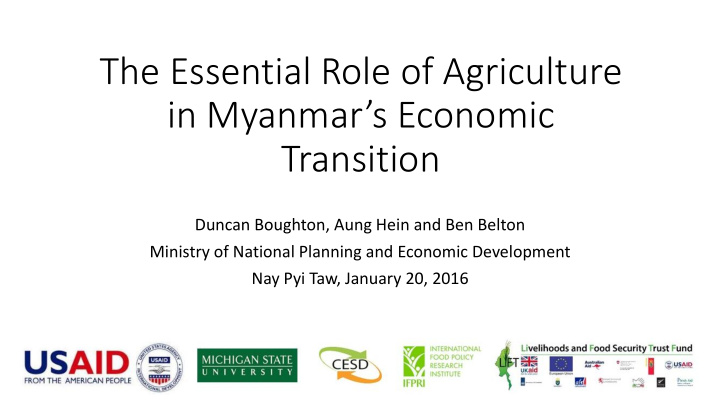



The Essential Role of Agriculture in Myanmar’s Economic Transition Duncan Boughton, Aung Hein and Ben Belton Ministry of National Planning and Economic Development Nay Pyi Taw, January 20, 2016
Why is agriculture important for a successful transition? Outline of presentation Typical transformation pathway for agriculture and the food system during economic transition Agriculture’s role in promoting rural economic growth and reducing income inequality Agriculture’s role in facilitating growth in other sectors of the economy How- to’s of improving agricultural incomes What should government do to ensure Myanmar agriculture is dynamic and competitive o Regional perspective o Union perspective 2
Typical agriculture and food system transformation in economic transition Diet changes and agriculture becomes more diversified o As incomes grow consumers spend more on meat, fish, fruit - less on rice Increased share of agricultural GDP is generated off-farm o Farm inputs and services (seeds, fertilizer, mechanization) o Food processing and distribution Agriculture’s contribution to GDP, employment and trade will grow more slowly relative to other sectors of the economy BUT Myanmar has a potential long-term competitive advantage in agriculture o Abundant land and water resources o Large regional markets (2.6 billion consumers) with growing food demand 3
Source: Timmer (2009) http://www.aei.org/files/2014/06/10/-a-world-without-agriculture-the-structural-transformation-in-historical- perspective_145442400043.pdf
Agriculture’s key role in promoting rural economic growth Most of Myanmar’s poor people live in rural areas o Most rural poor depend directly or indirectly on agriculture for income (farm production, on-farm employment, off-farm SME employment) o Not everyone migrates out of rural areas and their livelihoods need to be improved Incomes rise faster in urban areas during economic transition o Risk of rising income inequality between rural and urban areas Increased farm incomes have a multiplier effect on rural economy o 1 million kyat of agricultural income generates an additional 600,000 to 800,000 kyat in rural nonfarm income Agriculture has a critical role to i) lift millions of rural poor out of poverty, and ii) reduce the income gap between rural and urban populations 5
Agriculture facilitates growth of other sectors of the economy Food and nutrition security o Low wage inflation, improved educational outcomes o Stunting, underweight and obesity can co-exist during nutritional transition Engine to power growth of the rural economy Environmental services Raw materials for added value processing Source of export earnings o Beans and pulse exports earn more than $1 billion per year 6
How can agricultural incomes increase? Increase productivity (e.g., increasing number of baskets of paddy or pulses per acre cultivated) o Use of improved varieties or breeds of fish/livestock o Improved water and soil fertility management o Improved weed, pest and disease management Improvement in quality of produce Increase production of high value crops or livestock (e.g., pulses, fruits and vegetables, fish) Increase scale of production o Difficult in densely populated areas with high proportion of landless HH 7
8
Example of aquaculture as an opportunity for smallholders High profit and employment per acre compared to crops Rapid growth (Yangon has 30% of national pond area) Mainly large farmers at present Smallholder participation could increase dramatically with: o Freedom to convert paddy land to ponds o Access to credit and technical support Smallholder participation will increase incomes for local businesses Potential to improve aquaculture incomes through o Lower feed costs (only one company at present) o Diversification of species, and o Improved technology 9
Government’s role in promoting a dynamic agriculture: land & finance Increase investment on land by strengthening land tenure security o Secure tenure rights o Allow farmers choice of farm enterprise to have a mix of paddy and high value activities o Flexibility to rent or sell land to facilitate efficient allocation of land to actual users Improve agricultural finance for farmers and input companies o Reform ADB to be an effective and responsible financial partner o Medium-term finance for irrigation and farm equipment 10
Government’s role in promoting a dynamic agriculture: technology, information and data Make improved agricultural technologies available to farmers o Invest in agricultural research to improve varieties o Encourage domestic and foreign investment in seed sector o Promote smallholder access to small scale irrigation and mechanization o Re-organize extension services to earn farmer trust Improve farmers and traders access to information o Price o Buyers and sellers o Weather Improve agricultural statistics to monitor development of sector over time 11
Importance of a regional approach to increasing agricultural-led rural growth Different regions have different production and market opportunities o Altitude, water access, market access Example of Mon State with 3 distinct agro-ecologies: o Upland – increase profitability of rubber; diversification into fruit/vegetables o Lowland – increase productivity of rice production; diversification into aquaculture and more profitable crops such as beans/pulses o Coastal – improve management of marine capture; improve infrastructure for access to employment • Need to strengthen planning, statistics and extension services at regional level 12
Sound macro-economic, trade and investment policies (enabling environment) Flexible exchange rates o Important for farm prices and farmer incentives to invest in modern technology Investment in rural roads and electricity o Expansion of market opportunities and lower cost supply chains o Important for rural growth multipliers Encourage foreign direct investment in input supply and value added processing Trade facilitation Encourage market competition and market diversification Avoid price controls on agricultural products Help set quality and safety standards, and monitoring institutions o At inputs segment, monitoring of herbicides, pesticides and fertilizers import, sale and usage o At downstream segment, quality and safety assurances to both domestic and international consumers 13
Thank You for more information please contact: Aung Hein aunghein.cesd@gmail.com
Recommend
More recommend